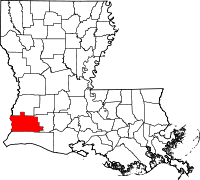Calcasieu Parish, Louisiana
| Calcasieu Parish, Louisiana | |
|---|---|

Calcasieu Parish District Courthouse
|
|
 Location in the U.S. state of Louisiana |
|
 Louisiana's location in the U.S. |
|
| Founded | March 24, 1840 |
| Named for | Atakapa word for crying eagle |
| Seat | Lake Charles |
| Largest city | Lake Charles |
| Area | |
| • Total | 1,094 sq mi (2,833 km2) |
| • Land | 1,064 sq mi (2,756 km2) |
| • Water | 31 sq mi (80 km2), 2.8% |
| Population (est.) | |
| • (2015) | 198,788 |
| • Density | 181/sq mi (70/km²) |
| Congressional district | 3rd |
| Time zone | Central: UTC-6/-5 |
| Website | www |
Calcasieu Parish[p] (French: Paroisse de Calcasieu) is a parish located in the U.S. state of Louisiana. As of the 2010 census, the population was 192,768. The parish seat is Lake Charles.
Calcasieu Parish is part of the Lake Charles, LA Metropolitan Statistical Area with a population of 194,138. It is also located near the Beaumont–Port Arthur (Texas), Lafayette, and Alexandria metropolitan areas.
Calcasieu Parish was created March 24, 1840, from the parish of Saint Landry, one of the original nineteen civil parishes established by the Louisiana Legislature in 1807 after the United States acquired the territory in the Louisiana Purchase of 1803. The original parish seat was Comasaque Bluff, a settlement east of the river and later called Marsh Bayou Bluff. On December 8, 1840, it was renamed as Marion, Louisiana.
In 1852 Jacob Ryan, a local planter and businessman, donated land and offered to move the courthouse in order to have the parish seat moved to Lake Charles. As the population in this area grew over the years, the original Calcasieu Parish has since been divided into five smaller parishes. The original area of Calcasieu Parish is called Imperial Calcasieu.
The name Calcasieu [p] comes from the Atakapan word, "quelqueshue" in a French transliteration, meaning "crying eagle." It was the name of an Atakapa chief, which French colonists applied to the local river, the Calcasieu River. When the Spanish controlled this area, they referred to this river as the Rio Hondo River (Rio Stondo or "Deep River"). The Americans adopted the French name in turn for the parish.
...
Wikipedia
